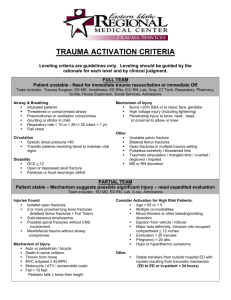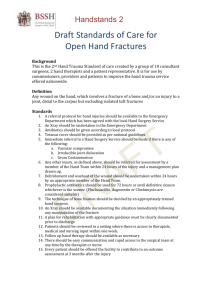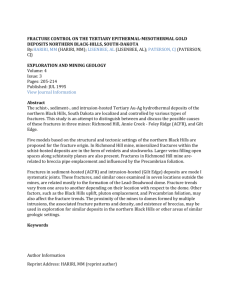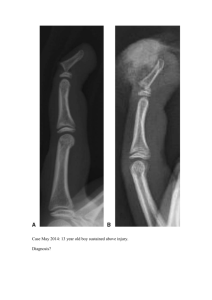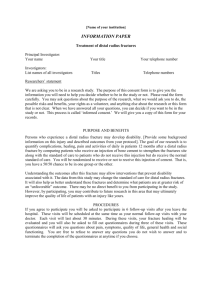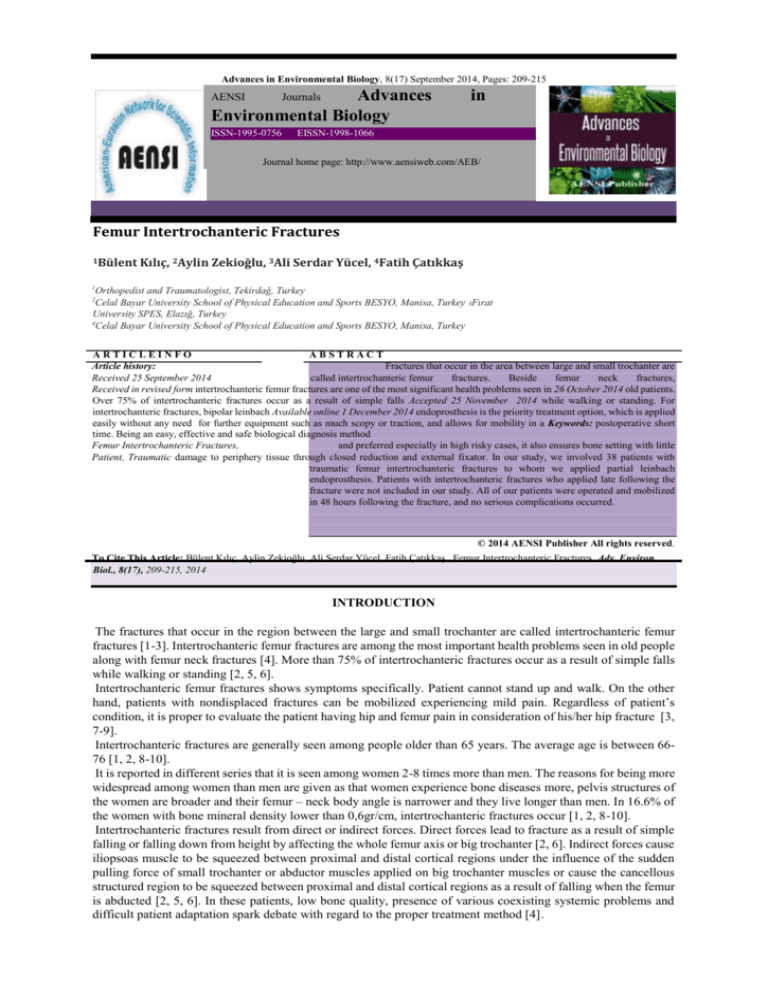
Advances in Environmental Biology, 8(17) September 2014, Pages: 209-215
Advances
Environmental Biology
AENSI
Journals
ISSN-1995-0756
in
EISSN-1998-1066
Journal home page: http://www.aensiweb.com/AEB/
Femur Intertrochanteric Fractures
1Bülent
Kılıç, 2Aylin Zekioğlu, 3Ali Serdar Yücel, 4Fatih Çatıkkaş
Orthopedist and Traumatologist, Tekirdağ, Turkey
Celal Bayar University School of Physical Education and Sports BESYO, Manisa, Turkey 3Fırat
University SPES, Elazığ, Turkey
4
Celal Bayar University School of Physical Education and Sports BESYO, Manisa, Turkey
1
2
ARTICLEINFO
ABSTRACT
Article history:
Fractures that occur in the area between large and small trochanter are
Received 25 September 2014
called intertrochanteric femur
fractures.
Beside
femur
neck
fractures,
Received in revised form intertrochanteric femur fractures are one of the most significant health problems seen in 26 October 2014 old patients.
Over 75% of intertrochanteric fractures occur as a result of simple falls Accepted 25 November 2014 while walking or standing. For
intertrochanteric fractures, bipolar leinbach Available online 1 December 2014 endoprosthesis is the priority treatment option, which is applied
easily without any need for further equipment such as much scopy or traction, and allows for mobility in a Keywords: postoperative short
time. Being an easy, effective and safe biological diagnosis method
Femur Intertrochanteric Fractures,
and preferred especially in high risky cases, it also ensures bone setting with little
Patient, Traumatic damage to periphery tissue through closed reduction and external fixator. In our study, we involved 38 patients with
traumatic femur intertrochanteric fractures to whom we applied partial leinbach
endoprosthesis. Patients with intertrochanteric fractures who applied late following the
fracture were not included in our study. All of our patients were operated and mobilized
in 48 hours following the fracture, and no serious complications occurred.
© 2014 AENSI Publisher All rights reserved.
To Cite This Article: Bülent Kılıç, Aylin Zekioğlu, Ali Serdar Yücel, Fatih Çatıkkaş., Femur Intertrochanteric Fractures. Adv. Environ.
Biol., 8(17), 209-215, 2014
INTRODUCTION
The fractures that occur in the region between the large and small trochanter are called intertrochanteric femur
fractures [1-3]. Intertrochanteric femur fractures are among the most important health problems seen in old people
along with femur neck fractures [4]. More than 75% of intertrochanteric fractures occur as a result of simple falls
while walking or standing [2, 5, 6].
Intertrochanteric femur fractures shows symptoms specifically. Patient cannot stand up and walk. On the other
hand, patients with nondisplaced fractures can be mobilized experiencing mild pain. Regardless of patient’s
condition, it is proper to evaluate the patient having hip and femur pain in consideration of his/her hip fracture [3,
7-9].
Intertrochanteric fractures are generally seen among people older than 65 years. The average age is between 6676 [1, 2, 8-10].
It is reported in different series that it is seen among women 2-8 times more than men. The reasons for being more
widespread among women than men are given as that women experience bone diseases more, pelvis structures of
the women are broader and their femur – neck body angle is narrower and they live longer than men. In 16.6% of
the women with bone mineral density lower than 0,6gr/cm, intertrochanteric fractures occur [1, 2, 8-10].
Intertrochanteric fractures result from direct or indirect forces. Direct forces lead to fracture as a result of simple
falling or falling down from height by affecting the whole femur axis or big trochanter [2, 6]. Indirect forces cause
iliopsoas muscle to be squeezed between proximal and distal cortical regions under the influence of the sudden
pulling force of small trochanter or abductor muscles applied on big trochanter muscles or cause the cancellous
structured region to be squeezed between proximal and distal cortical regions as a result of falling when the femur
is abducted [2, 5, 6]. In these patients, low bone quality, presence of various coexisting systemic problems and
difficult patient adaptation spark debate with regard to the proper treatment method [4].
210
Ali Serdar Yücel et al, 2014
Advances in Environmental Biology, 8(17) September 2014, Pages: 209-215
Corresponding Author: Ali Serdar Yücel, Fırat University, School of Physical Education and Sports Box. 23119. Elazığ.
Turkey.
Ph: +904242370000-5730.
E-mail: alsetu_23@hotmail.com. asyucel@firat.edu.tr.
Being conscious of the patient’s pre-fracture procedure is of importance for determining the level to be achieved
following the treatment. Activity level may decrease in many patients after the treatment. In fracture region, nearly
three units of bleeding occur. This leads to dehydration and hemoceoncentration in old patients. Shortness in
extremity and external rotation deformity up to 90 degrees might be observed. Localized ecchymosis is present in
hip region. This ecchymosis can only be seen in gluteal region in lateral fractures. Femur enlarges in association
with edema and bleeding. The movements are painful and patient cannot apply force on that lower extremity too
much. Trochanter minor fracture is present in hip fractures, fracture line is reverse oblique, varus angulation and
fracture line are vertical, there is apparent displacement in graphs and there is instability in fractures extending on
4-pieced subtrochanteric region [6].
The success of the surgical treatment depends on the stability of the fixed fracture [9]. The objectives in the
surgery are anatomic reduction of the fracture, stable fixation and early rehabilitation [11]. Various methods like
trochanteric plate application, intramedullary nails, methyl methacrylate or calcium based absorbable ceramics
and proximal femoral osteotomy are available as treatment alternatives [4, 12].
Endoprosthesis is another treatment method applied on the fractures in this region. Even tough this method is not
the ideal treatment method; it aims at helping the patient walk as soon as possible. The best treatment method is
still argued. Today, some changes can be observed in surgical approaches in parallel with the development in
technology. It is reported that complications like difficulty in bone fusion, fracture associated with material
inadequacy, and cut-out emerge following the internal fixation methods applied in unstable intertrochanteric
fractures [13]. Good results can be obtained in old patients with intertrochanteric fractures in early periods since
91% of the patients can regain their pre-fracture functions and that they don’t experience difficulty in applying
load postoperatively. Therefore, unipolar or bipolar hemiarthroplasty is a method applied in patients with bad
general condition, functional osteoporotic, visual and hearing loss restrictions and patients for whom controlled
rehabilitation is not possible following internal fixation [4, 11].
Advantages like shorter hospital stay, reduction in postoperative blood loss, reduction in surgery and anesthesia
that are achieved in minimal invasive surgery through biological osteosynthesis providing the acceptable reduction
of the fracture with indirect methods without damaging the soft tissues and disrupting the bone vascularization
and its fixation with a relative stability that allows for the limited movement of the fracture tips are also aimed to
be achieved in the treatment of the fractures in high risk patients groups [4, 11]. This study aims to express
treatment method in femur intertrochanteric fractures.
Treatment:
The treatment to be applied in intertrochanteric fractures is determined according to the patient related factors
like age, additional health problems, pre-trauma mobilization capacity, consciousness and fracture related factors
like bone quality, fracture type [14]. In the treatment of hip fracture, the success of the surgical technique and
postoperative low morbidity and mortality should be handled together. Therefore, pre-operative conditions of the
patients should be meticulously evaluated [15].
High mortality and morbidity were observed in old patients due to pressure sore, urinary tract infection, joint
contracture, pneumonia, thromboembolic complications. Surgical treatment is the priority option since it prevents
early mobilization and bed rest complications. However, conservative treatment might be performed in patients
with such a bad general medical condition that anesthesia and surgical procedure can increase patient mortality
and patients who are not able to mobilize before the trauma and who have fracture associated disturbance at an
ignorable level [9].
Fixation with external fixator is recommended in closed intertrochanteric fractures, as it is quick and traumatic
surgery, it provides sufficient stability and allows for early mobilization particularly in high-risk patients [15, 16].
Under closed reduction anesthesia, closed reduction is performed with direct traction and slight abduction; with
mild external rotation in multiple-piece fractures, with neutral position in case big trochanter is affected; with mild
internal rotation in stable fractures. If fracture reduction is not sufficient, open anatomical reduction should be
considered. In factures in which small trochanter remains solid, long protrusion of proximal fragment might be
squeezed between iliopsoas tendon and small trochanter. Closed reduction is not possible even with strong
traction. In reverse oblique fractures, post-reduction stability might not be achieved if DHS is not used. In these
kinds of fractures, fracture toothing or fixation with 95 degree angled plate and IM nails is recommended. In
instable situations where normal anatomy is not achieved, non-anatomical reduction methods were described with
the purpose of helping implant share the load with the bone in a balanced way by creating a stable configuration.
Dimon–Hungstone and Sarmiento methods are two examples [6, 17].
In these kinds of fractures, perioperative and postoperative period problems like loss of life, surgery time,
anesthesia depth can be reduced to minimum with low-damage surgical techniques. Fracture fixation with both
external fixator and intramedullary nail following closed reduction are biological fixation methods that bear all
these features and do not distrupt the fracture hematoma.
There are six main implant types in intertrochanteric fracture treatment.
211
Ali Serdar Yücel et al, 2014
Advances in Environmental Biology, 8(17) September 2014, Pages: 209-215
1- Changing angled nail plates
2- Fixed nail-plates
3- Sliding nail plates
4- Intramedullary nails
5- Endoprosthesis
6-External fixators
Changing angled nail plates and femur plate compatible with McLaughlin, Smith-Petersen nails and that has
toothed groove that can provide the desired angle during the operation in proximal and that can be fixed on the
nail with a special toothed nut or screw got rid of the difficulties in the treatment of intertrochanteric fractures.
An anatomical or non-anatomical stable reduction is strictly required before the application of stable angled nail
plates. The results obtained when implants like Holt, Jewett, which are not commonly used anymore and implants
like AO or Mittermainer, which are reported to have the capacity to make compression were utilized with good
stability by experienced people following the reduction are satisfactory. Penetration (cut-out) rates of these nails
per femur is reported to be high [3].
Another internal fixation method , medullary nails, are used more and more in the surgical treatment of the
intertrochanteric fractures thanks to the theoretical advantages they provide by shortening the lever arm reducing
the distance between hip joint and implant with its substantially durable material structure [10-16]. Rotational
instability and material related problems arisen following the treatment with standard intramedullary nails paved
the way for the improvement of proximal femoral nails (PFN) and their modification in 2004 (PFNA: proximal
femoral nail antirotation) [13].
Increased anterior slope of the femur should be taken into consideration while applying locked intramedullary
nails. Because the tip of the nail can cause a fracture by piercing the anterior cortex of the item or the nails cannot
be moved to distal and the screws can be placed in the upper quadrant. PFN is suitable for highly unbalanced
multiple-piece fractures for their biomechanical properties [6].
Yet another method, endoprosthesis, is used in multiple-piece and advance unstable fractures, in pathological
fractures in weak and old patients, in patients whose general medical conditions create rehabilitation difficulty, in
patients with failed internal fixation. Big trochanter is fixed with trochanter plate after unipolar or bipolar
prosthesis is used [6].
DHS (Dynamic Hip Screw) is considered as the standard method used in the treatment of the fractures. It helps
the screw fractures placed in the center of the femoral head intertwine by sliding with compressive loads. Angled
plates, a different method used, can be used with 95 or 135-degree angles. Other plates with stable angle (Jewett,
McLaughlin) or locked proximal femur plates can be utilized [6].
Sliding nail and plates are different methods used. The implants used in intertrochanteric fractures were fixed
angle nail plates (Jewett, Holt nail etc.). These implants fix femoral head and neck on femur body; however, it
was not allowing the impaction on fracture line. As a result of the lessons learnt from the fixed angled plates, nail
plating enabling controlled fracture impactions were developed (Massie, Ken-Pugh nails). Nail tips were obtused
and their groove diameters were enlarged in order to prevent penetration of nail tips of the sliding nail-plate
implants and increase the stabilization of proximal fragment in time [9].
Sliding hip screw has major disadvantages like leading to varus deformity in fracture, developing shortness in the
extremity and sliding the distal fragment to medial [5, 10]. Proximal femoral nail application is another method
[14]. Proximal Femoral Nail (Synhtes) (Paoli,PA) is a cephamedullary nail .Among the lag screws, the one in
the superior is 6 mm and the one in the inferior is 11 mm [9]. Especially in unstable fractures, lag screw related
tear, cortical screw loosening and implant failures can be observed 5-20% with both methods. The frequency of
the mechanical complications observed in the external fixtures is lower compared to the other two methods [14].
Trochanteric Fixation Nail is a cephamedullary nail with lag screw replaced with helical head screw. Helical
head can display more resistance to rotational forces and varus collapse compared to the other lag screws. Helical
screw has 11 mm caliber and causes less bone loss from femoral head and neck compared to conventional lag
screws when the screw is turned [9].
Even tough prostatic replacement method is a good option in the treatment of displaced femur neck fractures, its
indication is limited in intertrochanteric fractures. The prosthesis that will be used in intertrochanteric fractures
should be calcar supported and trochanter should be fixed again for protecting abductor function [9, 16-20].
External fixator is not a commonly applied method in intertrochanteric fractures. It can be performed in certain
patients due to short operation time, minimal loss of life and the presence of only local anesthesia complications.
System consists of fixation of 2 or 3 Scahnz screws that are sent 10 mm below the subchondral bone longitudinally,
on the proximal femur. The estimated duration of external fixator is 90 days, and implant can be removed under
policlinic conditions. Although good results were obtained in literature, bone fusion on wrong position and nail
bottom infections occur 12% and 7-44% respectively. It was observed that nail bottom infections result in
osteomyelitis [9, 16-21].
In the treatment of intertrochanteric fractures, operation time in external fixator application is 10-75 minutes and
hospital stay is 2-19 days. Loss of life during operation occurs at a negligible rate [14].
212
Ali Serdar Yücel et al, 2014
Advances in Environmental Biology, 8(17) September 2014, Pages: 209-215
Compared with the external fixator in the general sense, intramedullary fixation method is more invasive. Implant
choice is of particular importance in these kinds of osteoporotic fractures [22, 23]. The ideal methods should
provide stability and prevent deformity formation [14].
Nail infection risk in the treatment of hip fractures with external fixators is reported as 0-30% in various studies
[14].
In the treatment of hip fractures with external fixation, operation time is short, the surgical reduction achieved is
permanent. Consequently, this technique is one of the methods that can be preferred in the treatment of the high
risk patients with intertrochanteric fractures as it is minimally invasive, doesn’t not cause bleeding, does not inflict
damage on the soft tissue and bones [14].
Application:
38 patients with femur intertrochanteric fractures applied to our emergency for various reasons were included in
our study (Figure 1). The age interval of our patients is 72-94 and the mean age is about 80.1. 26 of the patients
are female, 12 of them are male. Our patients had chronic diseases like diabetes mellitus, osteoporosis, obesity,
hypertension, chronic liver failure, hypothyroidism, hyperlipidemia. There is no case with pathological fracture
in our patients. All of our students are patients who were mobile and active before the fracture.
All of our patients were referred to emergency a couple of hours later than the fracture occurred. There was no
open wound in the physical examination. Hip region sensitivity, shortness in the relevant lower extremity, internal
rotation, adduction posture and enlargement associated with hip region hematoma were detected in physical
examination. No venous or neural trauma was observed in our patients. Femur intertrochanteric fracture diagnosis
was made in all of the patients through direct hip graphs. All were admitted to the hospital by the traction
performed on the ankle. Anesthesia evaluation, antibiotics, low molecule weighted heparin, analgesic and liquid
replacement were started. In average, our patients were taken under operation 13 hours after hospital admission.
General and spinal anesthesia were performed. All patients were laid down laterally and fixed. Probing was
performed. Hip region was brushed with baticon soap and dried. The relevant lower extremity of the patient was
prepared sterially and hip region was draped with ioban. Posterior hip incision was applied on all patients. Gluteal
muscles were protected by dissecting manually. Sciatic nerve was protected. Joint capsule was opened and
protected. Fracture hematoma was removed. Upon revealing the fracture line, fractured proximal part of the femur
was excised by preserving the trochanter major. All the bone fragments in the region were eliminated and
cleansing was performed. Trochanter minor was opened and free parts were excised. In all patients, medulla was
rasped, prepared and washed properly. Pre-implantation measures were performed with experimental prosthesis.
Aspirative drain was put into medulla and was cemented and partial leinbach prosthesis was implanted by
removing the drain. Prosthesis was reduced. Capsule was repaired. Plate, ethibond sew and circlage wire were
used for trochanter major repair (Figure 3). The layers were covered with melting sewing material by putting 1
aspirative drain, and operation is finalized. Drains of all patients were removed 24 hours after the operation, and
patients were mobilized. Medical treatment was arranged in a way that in average, in 3 postoperative days, patients
were successfully mobilized, were discharged and clinically followed up.
All the patients were easily mobilized and reached the pre-operative mobility levels. Minor anesthesia
complications (temporary dementia and intubation irritation problems etc.) occurred and 7 patients experienced
serous liquid drainage from wound area. It was observed that our patients suffered from temporary adductor
regional pains.
Discussion:
Intertrochanteric fractures are mostly seen in people over 65 years. The average age is between 66-76 [1, 2, 810]. For intertrochanteric fractures, bipolar leinbach endoprosthesis is the priority treatment option, which is
applied easily without any need for further equipment such as scopy or traction, and allows for mobility in a
postoperative short time. [24]. Besides, the treatment of intertrochanteric fractures developing at old ages with
closed reduction and external fixator is an easy, effective and safe biological diagnosis method and provides bone
fusion by giving little damage to periphery tissue, and is preferred especially in high risky cases [25]. In these
patients, low bone quality, various coexisting systemic problems and difficult adaptation of the patient spark
debate with regard to the proper treatment method [4]. Therefore, unipolar and bipolar hemiarthroplasty are
methods applied in patients with bad general condition, functional osteoporotic, visual and hearing loss
restrictions and for whom controlled rehabilitation is not possible following internal fixation [4, 11].
In our study, we were able to mobilize our patients in a short time (in average 36 hours after the fracture) through
the leinbach partial prosthesis we applied on 38 old aged patients (in average 80.1) with intertrochanteric femur
fractures (Figure 1,2,3). No serious complication arose. Our patients reached the preoperative mobility levels. The
fact that chronic problems of the patients (diabetes mellitus, osteoporosis, obesity, hypertension, chronic liver
disease, hypothyroidism, hyper lipidemia etc.) were likely to affect tissue healing potential and our patients were
old aged were the reasons for applying leinbach prosthesis. With regard to the good results we obtained in our
patients, we believe that early application to our unit, application of the surgery and mobilization in a short time
are of importance.
213
Ali Serdar Yücel et al, 2014
Advances in Environmental Biology, 8(17) September 2014, Pages: 209-215
We believe that the patients in our study were mobile and active and their general medical conditions were not
bad played a role in obtaining these successful results. The restriction of our study is non-inclusion of various
diseases that disrupt body performance substantially and patients with pathological fractures. In prosthesis
operations, implant infection risk should not be disregarded. That all patients applied to our unit at an early period
has an impact on the positive result we obtained. All of the operations were performed by the same surgeon.
Therefore, our study does not include surgical application differences and this is our study’s limitation.
Conlusion:
As a result, for intertrochanteric fractures, bipolar leinbach endoprosthesis is a significant treatment option, which
is applied easily without any need for further equipment such as scopy or traction, and allows for mobility in a
postoperative short time.
We believe even tough our patients are old aged patients, that they applied to our unit, early, our application of
the surgery and that we mobilized our patients in a short time yielded good results. Early mobilization is as
important as choosing the operation method for hip fracture cases that can lead to death especially in old age
groups. We don’t recommend the methods, which have long fusion time and prevent mobilization in patients with
bad general medical condition and in old aged patient groups.
Contribution of Authors:
The authors Aylin Zekioğlu, Fatih Çatıkkaş and Ali Serdar Yücel gave support in the translation and
summarization of the sources used in the research in addition to literature support.
REFERENCES
[1]
[2]
[3]
[4]
[5]
[6]
[7]
[8]
[10]
[11]
[12]
[13]
[14]
[15]
[16]
Kurtulmuş, T., 2006. Femur Trokanterik Bölge Kırıklarında Pfn (Proksimal Femoral Nail) Uygulamalarımız
Ve Sonuçları, Dissertation, T.R. Taksim Training and Research Hospital, Clinic of Orthopedics and
Traumatology, Chief of Orthopedics and Traumatology Clinic, İstanbul
Browner, D.B., J.B. Jüpiter, A.M. Levine, and P.G. Trafton, 1996. Skeletal Trauma, V:2,1833-1926, WB
Saunders Company.
DeLee, J.C, 1996. Fractures and Dislocations of the Hip, Rockwood and Green's Fractures in Adults, Vol.:2,
1659-1827, Lippincott-Raven.
Kara, A., Y. Öç, A. Şeker, M. Uzun, E. Ertürer; and İ. Öztürk, 2013. İntertrokanterik kırık sonrası nadir
görülen bir parsiyel protez çıkığı, Şişli Etfal Hospital Medical Bulletin, Volume: 47, No: 3.
Müller, M.E., M. Allgöwer, R. Schneider, and H. Willenegger, 1991. Manuel of internal fixarion: techniques
recommended by the AOASİF group,ed 3, Berlin, Springer-Verlag).
Aksu, Işıklar, N. and U. Zekeriya, 2008. Kalça Kırıkları, TOTBİD (Turkish Society of Orthopedics and
Traumatology) Journal, Volume: 7 No: 1-2
Browner, D.B., J.B. Jüpiter, A.M. Levine, and P.G. Trafton, 1998. Skeletal Trauma, V: WB Saunders
Company.
Ege, R, 1994. Kalça Cerrahisi ve Sorunları; Turkish Aeronautical Association Publising House Ankara. [9]
Bayhan, A.İ, 2007. İnstabil İntertrokanterik Femur Kırıklarında Proksimal Femoral Çivi Uygulamalarımız
Ve Sonuçları, Dissertation, T.R. Dr. Lütfi Kırdar Kartal Training and Research Hsopital, 1 st Clinic of
Orthopedics and Traumatology, İstanbul.
Hinton, R.Y., D.N. Lennox, F.R. Ebert, and G.S. Smith, 1995. Relative Rates of Fracture of the Hip in the
United States. J. Bone Joint Surg Vol. 77-A, No.5, 695-702.
Sancheti, K.H., P. Sancheti, A. Shyam, S. Patil, Q. Dhariwal and R. Joshi, 2010. Primary hemiarthroplasty
for unstable osteoporotic intertrochanteric fractures in the elderly: A retrospective case series. Indian J
Orthop 44(4), 428-34.
Pajarinen, J., J. Lindahl, O. Michelsson, V. Savolainen, and E. Hirvensalo, 2005. Pertrochanteric femoral
fractures treated with a dynamic hip screw or a proximal femoral nail. A randomised study comparing postoperative rehabilitation. J Bone Joint Surg Br, 87, 76-81.
Uzun, M., E. Ertürer, I. Oztürk, S. Akman, F. Seçkin, and I.B. Ozçelik, 2009. Long-term radiographic
complications following treatment of unstable intertrochanteric femoral fractures with the proximal femoral
nail and effects on functional results. Acta Orthop Traumatol Turc, 43(6), 457-63.
Edipoğlu, E., M.G. Bilgili, C. Sarı, S.H. Başaran, C. Kural, and M.C. Avkan, 2013. Geriatrik Hastalardaki
İntertrokanterik Femur Kırıklarının Eksternal Fiksatörle Tedavisi, Bakırköy Tıp Journal, Volume 9, No 1.
Yılmaz, C, 2005 Yüksek Cerrahi Riski Bulunan İntertrokanterik Femur Kırıklı Hastalarda Eksternal
Fiksatör Uygulaması Ve Sonuçlarımız, (Dissertation), T.R. Ministry of Health, Şişli Etfal Training and
Research Hospital, 1st Clinic of Orthopedics and Traumatology, İstanbul
Chaim, S.H., D.P. Mukherjee, A.L. Ogden, R.H. Mayeux, K.K. Sadasivan, and J.A. Albright, 2002. A
biomechanical study of femoral neck fracture fixation with the VHS hip fixtion system. Am J Orthop, (Suppl
1), 22-24
214
Ali Serdar Yücel et al, 2014
Advances in Environmental Biology, 8(17) September 2014, Pages: 209-215
[17] Canale, S.T, 2003. (ed): Campbell’s Operative Orthopaedics, 10 th ed.St Louis, Mosby, Hip Fracture. David
G. Lavelle Chapter 52, p 2873-2938
[18] Chan, K.C, and G.S. Gill, 2000. Cemented Hemi artroplasties for elderly patients with intertrochanteric
fractures. Clin Orthop 371.
[19] Green, S., T. Moore, and F. Proana, 1986. Bipolar prosthetic replacement of unstable intertrochanteric hip
fractures in the elderly. Clin Othop, 224,169-177.
[20] Moroni, A., C. Faldini, P, Pegraffi, et al, 2003. External fixation revisited: a new treatment option for elderly
patients with trochanteric fractures. Annual OTA meeting.
[21] Eksioğlu, F., Güdemez E, T. Çavusoğlu, and S. Behçet, 2000. Treatment of intertrochanteric fractures by
external fixation. Bull Hosp Joint Dis, 59, 131-135.
[22] Özkaya, U., A.S. Parmaksızoğlu, M. Gül, Y. Kabukçuoğlu, G. Özkazanlı, and S. Basılgan, 2008.
Osteoporotik yaşlı hastalarda pertrokanterik kırıkların eksternal fiksasyonla tedavisi. Acta Orthop Traumatol
Turc 2008; 42, 246-251.
[23] Baumgaertner, M.R, 2002. The pertrochanteric external fixator reduced pain, hospital stay, and mechanical
complications in comparison with the sliding hip screw. J Bone Joint Surg Am, 84, 1488.
[24] Malkoç, M., and C. Kural, 2006. Stabil Olmayan İntertrokanterik Femur Kırıklarında Primer Bipolar
Leinbach Parsiyel Endoprotez Uygulamaları ve Sonuçları, Haseki Journal, No. 21.
[25] Atıcı, T., N. Şahin, A. Öztürk, and O. Yaray, 2010. İleri Yaşlı (≥65 Yaş) Yüksek Riskli Olgularda Gelişen
İntertrokanterik Femur Kırıklarının Eksternal Fiksatörle Tedavisi, Ulus Travma Acil Cerrahi Journal, 16 (5),
41.
Appendix:
Fig. 1: Patient with femur intertrochanteric fracture.
215
Ali Serdar Yücel et al, 2014
Advances in Environmental Biology, 8(17) September 2014, Pages: 209-215
Fig. 2: Patient with femur intertrochanteric fracture on whom we applied Leinbach partial prosthesis.
Fig. 3: Fixation of fracture trochanter major of the patient with femur intertrochanteric fracture on whom we
applied Leinbach partial prosthesis by means of circlage.

